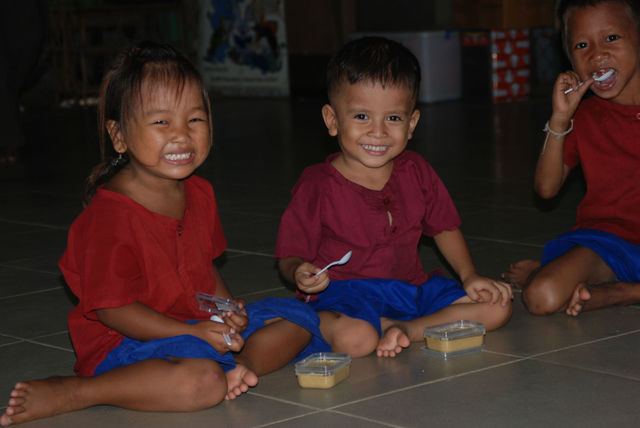Innovative food supplements take a bite out of malnutrition in Cambodia
2015-10-27
By Samoeurn Un and Arnaud Laillou

© UNICEF Cambodia/2015/Arnaud Laillou
Students of an NGO-run preschool testing different food supplements.
In Cambodia, many children aged between 6 months and 2 years do not receive the right foods to ensure they grow up healthy and strong. A recent survey showed that only one in five babies aged 6 to 8 months is fed the recommended minimal acceptable diet. A third of children under 5 show high levels of stunting, and a quarter are seriously underweight. One in 10 suffers from acute malnutrition.
Malnourished children can struggle with lifelong consequences, including impaired physical and cognitive development.
That’s why UNICEF partnered with Dr. Frank Wieringa, a Dutch researcher at the Institut de Recherche pour le Développement, to develop a nutritious, locally made food supplement to offer Cambodian caregivers the chance to add important vitamins and minerals to their children’s daily food intake.
Little taste-testers
In 2014, UNICEF conducted a field assessment in poor Phnom Penh communities and found that snacks comprise 6 to 7 per cent of total household expenditure. Dr. Chhoun Chamnan, director of the Department of Fisheries Post-Harvest Technologies and Quality Control, talks about the findings. “Yes, Cambodians love snacking! But most snacks contain high amounts of sugar and not much else. If a healthy alternative were made available for the same price, I am convinced that people would buy it.”
With Dr. Wieringa, we set out to find this alternative. First, we identified a Cambodian non-profit food company, Vissot, which is certified by the Ministry of Health to produce micronutrient-enriched local products. Vissot works with development partners to produce and supply inexpensive products to rural and urban communities that can influence the future nutritional status of Cambodian children.
What would the team produce? “We needed a product adapted to Cambodian taste preferences,” says Dr. Wieringa. “We couldn’t just adopt what we developed earlier in neighbouring countries if we wanted to reach our target population.”
And so the development of a fishy cube began.
The team created a food supplement consisting of fish, rice, mung bean, soy, oil, sugar and micronutrients, packaged as cubes. Ingredients were selected for nutritional qualities, local availability, cost and cultural preferences.
Would the snack be accepted? The partners conducted a study among a target group – dozens of children aged between 2 and 7 years old attending an NGO-run preschool in an urban slum in Phnom Penh.
Children noted a strong fishy smell and that the cubes did not look appetizing.
Building a better wafer
So, the team rethought the package. Given the high consumption of snacks, even among young children, Dr. Wieringa suggested adding the supplement to a wafer commonly produced and eaten in Cambodia. The assumption was that this would lead to higher acceptance since it looks more like a snack Cambodians would normally consume. In addition, coconut powder was added to improve the smell and taste.
|
Through acceptability tests we conducted, we found out that children found these wafers more palatable than the previous food supplement cubes.
Before introducing the crackers nationally in 2016–2017, we will test how effective they are. The tests will look at nutritional outcomes of children aged 6 to 17 months, along with pregnant and lactating women.
“These final tests are essential, as Cambodia is one of the first countries to use fish protein. Milk [or whey] powder is the animal-source food most commonly used in supplementary and therapeutic foods,” says Dr. Wieringa. |
 © IRD Cambodia/Wieringa
The food supplement developed and being tested by UNICEF, IRD and DFPTQ. |
Animal-source foods added to complementary food are associated with improved micronutrient status, linear growth and non-fat mass gain. The World Health Organization recommends daily consumption of animal-source foods in porridge for children aged 6 to 24 months.
Milk and whey powders have to be imported into Cambodia, whereas fish is abundant and essential to the local diet, making it a palatable, familiar and cost-effective component.
At a later stage, and particularly for pregnant and lactating women, the snack may be produced in different flavours, such as pandan or chili, to attract different target groups. “It is essential for a social enterprise like Vissot to develop a range of products with the same base of raw materials and process, explains Vissot’s Managing Director Lyndon Paul. “It allows us to reach a bigger market and therefore reduce the cost of production.”
Once all tests demonstrate this product’s ability to stem malnutrition among Cambodian children, UNICEF will develop a business model to ensure the sustainability of this food supplement and make it available through social marketing models.
Through our combined efforts and expertise, we hope that soon all young Cambodians will be enjoying this delicious and vitally important snack, crunching their way to a healthier, happier future.
| Donate now to support UNICEF’s programmes worldwide |









